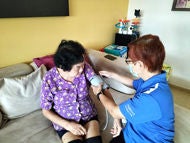What is - Acute Pharyngitis and Tonsillitis
What are acute pharyngitis and tonsillitis?
Acute pharyngitis and acute tonsillitis are common infections that affect different areas of the upper throat.
Acute pharyngitis typically refers to inflammation of the back of the throat, leading to soreness, irritation and difficulty swallowing.
Acute tonsillitis, on the other hand, refers to inflammation of the tonsils, which are two oval-shaped lymphoid tissues located on either side at the back of the throat. It typically presents with swollen tonsils, throat pain and fever.
In some cases, both the pharynx and the tonsils may become inflamed simultaneously. This condition is known as pharyngotonsillitis. It shares features of both acute pharyngitis and tonsillitis, and is commonly caused by viral or bacterial infections, with group A Streptococcus being a frequent bacterial culprit. Pharyngotonsillitis is often more symptomatic than isolated pharyngitis or tonsillitis, and treatment depends on the underlying cause. Bacterial infections may require antibiotics, whereas viral cases are typically managed with supportive care.
Symptoms of Acute Pharyngitis and Tonsillitis
What are the symptoms of acute pharyngitis and tonsillitis?
Signs and symptoms of pharyngitis include:
- Sore throat
- Fever
If tonsillitis occurs, you may experience:
- Severe sore throat
- Painful and difficult swallowing
- Referred pain to the ear
- Fever and chills
- Changes of your voice (due to inflammation of voice box)
- Headache
- Tender and enlarged lymph glands in the neck
- Red and swollen tonsils and white patches on the tonsils
When should you see a doctor?
You should see a doctor if your symptoms persist for more than a few days, worsen despite home care or interfere with eating, drinking or breathing. Seek medical attention immediately if you experience difficulty opening your mouth, excessive drooling in children or signs of dehydration such as reduced urination or extreme fatigue. Recurrent throat infections or a history of complications, such as abscess formation, may also require professional assessment by a specialist.
What are the potential complications of acute pharyngitis and tonsillitis?
Potential complications of acute pharyngitis
In rare instances, untreated pharyngitis caused by specific bacteria, such as Group A Streptococcus, may lead to systemic complications like rheumatic fever or post-streptococcal glomerulonephritis. These can affect the heart, joints, skin or kidneys.
Potential complications of acute tonsillitis
Acute tonsillitis itself is usually not serious but can lead to complications if left untreated. Swollen tonsils can block the airway and cause airway obstruction leading to sleep apnoea.
The infection may spread to the surrounding tissue and neck and result in the collection of pus between the tonsil and tissues around it (peritonsillar infection and abscess). It can also spread to the neck causing pus collection in the neck (parapharyngeal abscess and retropharyngeal space abscess). You can present with difficulty swallowing, drooling, stiff neck or pain and difficulty breathing.
Acute Pharyngitis and Tonsillitis - How to prevent
How are acute pharyngitis and tonsillitis prevented?
The viruses and bacteria that cause pharyngitis and tonsillitis are contagious. Personal hygiene is important to prevent infections and frequent hand washing is the best way to do so. Wash your hands often and encourage your children to do the same.
Other precautionary measures include not sharing drinking glasses or eating utensils, covering the mouth when sneezing or coughing and avoiding close contact with anyone who is sick.
Parents should also keep their children at home if they are sick to prevent spreading the germs to others.
Acute Pharyngitis and Tonsillitis - Causes and Risk Factors
What causes acute pharyngitis and tonsillitis?
The pharynx and tonsils have lymphoid tissue (white blood cells) that form part of the defense mechanism against viruses and bacteria that enter the body through the nose or mouth.
Pharyngitis and tonsillitis are caused mainly by viruses. Less often, it may be the result of bacterial infection and antibiotic treatment will be required.
Most cases of sore throat are the result of acute pharyngitis. Tonsillitis occurs when the infection gets more serious and the tonsils become painful and inflamed.
Tonsillitis caused by viruses
The majority of tonsillitis cases are caused by viruses (e.g., Adenovirus, Influenzae viruses, Parainfluenzae virus, Respiratory Syncytial Virus) that can affect the upper respiratory tract, including the virus that causes infectious mononucleosis (the Epstein-Barr virus). Tonsillitis can also be caused by bacterial infections (e.g., Streptococcus species, Staphylococcus species).
Acute tonsillitis caused by the Epstein-Barr virus can cause infectious mononucleosis. It is also called the ‘kissing disease’ because it is spread via saliva and commonly affects adolescents and young adults. It is characterised by:
- Sore throat
- Fever
- Enlarged cervical lymph nodes
- Enlarged tonsils and fatigue
Other clinical manifestations are splenomegaly (enlarged spleen), hepatomegaly and hepatitis (enlarged liver and inflammation of the liver), and low platelet and white blood counts.
Tonsillitis caused by bacteria
Acute tonsillitis due to a specific type of bacteria (Group A Streptococci) is called Streptococcal pharyngitis, or a “strep throat”.
Symptoms caused by a “strep throat” include:
- A sudden onset of pain and pain on swallowing
- Tender lymph glands in the neck
- High spiking fever
- A lack of upper respiratory tract symptoms (e.g., running nose, nasal blockage)
As most cases of tonsillitis are caused by viruses, symptomatic treatment with painkillers, fever medications and hydration is enough. However, if the infection is caused by strep throat or another bacterial infection, treatment with antibiotics is needed.
School-going children are prone to viruses and bacteria that cause upper respiratory tract infection and tonsillitis. These tend to get passed on in childcare centres and schools where children are nearby.

What are the risk factors for acute pharyngitis and tonsillitis?
Risk factors for acute pharyngitis and tonsillitis include:
- Close contact with infected individuals, particularly in crowded environments such as schools, childcare centres or workplaces
- Poor hand hygiene and sharing utensils or drinks, which can facilitate the spread of infections
- Weakened immunity due to underlying health conditions, stress or fatigue
- Seasonal changes, especially during colder months, when respiratory viruses circulate more widely
- Exposure to environmental irritants such as smoke, pollution or dry air, which can inflame the throat and increase vulnerability to infection
Diagnosis of Acute Pharyngitis and Tonsillitis
The diagnosis of acute pharyngitis and tonsillitis involves a combination of clinical assessment and diagnostic tests to determine the cause and identify any complications. These may include:
- Medical history: The clinician will take a detailed history, including the onset, duration and progression of symptoms such as sore throat, fever, difficulty swallowing, voice changes and any recent exposure to individuals with similar symptoms. Other associated symptoms like cough, runny nose, headache or fatigue may also be considered to help differentiate between viral and bacterial causes.
- Physical examination: A thorough examination of the mouth and throat is performed to check for redness, swelling of the pharynx or tonsils, presence of white patches, pus (exudates), ulcers or petechiae. The neck is palpated to assess for enlarged or tender lymph nodes. In cases of tonsillitis, the tonsils may appear significantly enlarged and may obstruct the airway.
- Throat swab and culture: A swab may be taken from the back of the throat and tonsils to test for specific bacterial pathogens, most commonly Group A Streptococcus (GAS). The sample may be sent for a standard bacterial culture, which typically takes 24 to 48 hours, or tested using a rapid antigen detection test (RADT), which can provide results within minutes. While RADTs are useful for quick diagnosis, they may not detect all cases, so a negative result is sometimes confirmed with a throat culture.
- Full blood count (FBC): A blood test may be performed to assess for signs of systemic infection or inflammation. A raised white blood cell count may suggest a bacterial infection, while a normal or mildly elevated count is more typical of viral infections.
- C-reactive protein (CRP) or erythrocyte sedimentation rate (ESR): These inflammatory markers may be tested in certain cases to help assess the severity of infection, especially in more complicated or uncertain cases.
- Monospot test or Epstein–Barr virus serology: If infectious mononucleosis is suspected, especially in adolescents and young adults presenting with prolonged sore throat, fatigue and enlarged lymph nodes, a blood test may be used to detect antibodies to the Epstein–Barr virus.
- Radiological investigations: If complications are suspected, such as peritonsillar abscess, parapharyngeal abscess or retropharyngeal abscess, imaging may be required. This may include a lateral neck X-ray, neck ultrasound or contrast-enhanced CT scan to evaluate the extent and location of the infection.
- Laryngoscopy: In cases where voice changes, hoarseness or signs of upper airway obstruction are present, a flexible nasopharyngolaryngoscopy may be performed to assess the pharynx, larynx and upper airway directly.
Treatment for Acute Pharyngitis and Tonsillitis
How are acute pharyngitis and tonsillitis treated?
Treatment for acute pharyngitis and acute tonsillitis depends on the underlying cause, which is most often viral, although some cases may be bacterial. The primary aim of treatment is to relieve symptoms, support recovery and prevent complications. Management strategies are similar for both conditions, as they often share overlapping symptoms and causes.
Self-care
The majority of cases of pharyngitis and tonsillitis are viral in origin. These infections are usually self-limiting and resolve within a week. In such cases, antibiotics are not required, and supportive care is the mainstay of treatment. Simple measures to ease discomfort include:
- Drinking plenty of fluids to prevent dehydration
- Sipping warm, soothing liquids such as broth, tea or soup
- Gargling with warm salt water to reduce throat irritation
- Taking paracetamol or ibuprofen to lower fever and relieve pain
Children should not be given aspirin due to the risk of Reye’s syndrome, a rare but serious condition that may lead to brain damage and liver complications. Individuals diagnosed with infectious mononucleosis, a common viral cause of pharyngitis, should avoid strenuous activity for at least one month due to the risk of splenic rupture.
Antibiotics for bacterial infections
If either acute pharyngitis or acute tonsillitis is caused by a bacterial infection, such as group A Streptococcus, antibiotics may be prescribed. It is important to complete the full course to ensure the infection is fully treated and to prevent the development of antibiotic resistance. Bacterial infections are more likely to require medical evaluation, particularly if symptoms are severe or persistent.
Corticosteroids
In cases where there is significant swelling of the throat or severe pain, a short course of corticosteroids such as dexamethasone may be administered to reduce inflammation and provide rapid relief. This may be considered for both pharyngitis and tonsillitis, especially when swallowing or breathing is affected.
Antiviral therapy
Antiviral medications are rarely needed but may be considered for pharyngitis or tonsillitis caused by specific viruses such as influenza, or in immunocompromised individuals with infections like herpes simplex virus. These cases are uncommon and treatment decisions are made based on clinical assessment.
Surgery
In recurrent or chronic cases of tonsillitis, surgical removal of the tonsils (tonsillectomy) may be advised. This procedure is not applicable to isolated pharyngitis. A tonsillectomy may be considered if a patient experiences:
- Seven or more serious throat infections in one year
- Five or more infections per year over two consecutive years
- Three or more infections per year over three consecutive years
- Persistent or chronic tonsillitis unresponsive to medical therapy
Tonsillectomy may also be recommended if there is an abscess that does not respond to antibiotics or if breathing is compromised due to enlarged tonsils.
Recovery from a tonsillectomy or from severe infections may take up to two weeks. During this period, rest, hydration and appropriate pain management are essential.
FAQs on Acute Pharyngitis and Tonsillitis
Acute pharyngitis refers to inflammation of the pharynx, the part of the throat behind the mouth and nasal cavity, often causing a sore throat, difficulty swallowing and irritation. Tonsillitis, on the other hand, is the inflammation of the tonsils, which are lymphoid tissues located at the back of the throat. While both conditions can occur together and share similar symptoms, pharyngitis affects the broader throat area, whereas tonsillitis specifically involves the tonsils.
Yes, pharyngitis is often contagious, particularly when caused by viral or bacterial infections. It can spread through respiratory droplets from coughing, sneezing or close contact with an infected person. Practising good hand hygiene and avoiding sharing utensils or drinks can help reduce the risk of transmission.
Yes, viral pharyngitis usually resolves on its own within a few days to a week with rest, fluids and symptomatic care. Bacterial pharyngitis may also improve without treatment, but antibiotics are often prescribed to reduce the risk of complications and to shorten the duration of symptoms.
Viral and bacterial infections can cause similar symptoms, but bacterial tonsillitis, such as strep throat, often leads to a sudden onset of severe pain, high fever and swollen lymph glands without typical cold symptoms like a runny nose or cough. A doctor may perform a throat swab to confirm if a bacterial infection is present and whether antibiotics are needed.
You should seek medical advice if symptoms are severe, persist for more than a few days or cause difficulty breathing, swallowing or opening the mouth. If there are recurrent episodes of tonsillitis affecting daily life, a doctor may discuss further treatment options, including the possibility of tonsil removal in some cases.
A sore throat is one of the most common symptoms of tonsillitis, but in some cases, other symptoms such as fever, difficulty swallowing, swollen lymph glands or general fatigue may be more noticeable. In young children, refusal to eat or drink can sometimes be the first sign of tonsillitis.
References
Cobblestone Throat (acute pharyngitis) sign & treatment. Ada. (n.d.). https://ada.com/conditions/acute-pharyngitis/
UpToDate. (n.d.). https://www.uptodate.com/contents/acute-pharyngitis-in-children-and-adolescents-symptomatic-treatment
Osmosis. (n.d.). Pharyngitis: Nursing. Osmosis. https://www.osmosis.org/learn/Pharyngitis:_Nursing
Contributed by
The information provided is not intended as medical advice. Terms of use. Information provided by SingHealth.
Condition Treated At
Department
Otorhinolaryngology - Head &Neck Surgery
Department
Otorhinolaryngology- Head & Neck Surgery
Get to know our doctors at SingHealth Hospitals in Singapore.
Get to know our doctors at SingHealth Hospitals in Singapore. here.




















